Using TravelPac Q3 2017 Data to Analyze UK Resident Travel Patterns
VerifiedAdded on 2020/10/22
|18
|2875
|138
Report
AI Summary
This report analyzes the TravelPac Q3 2017 data to understand travel patterns of UK residents and overseas visitors. It examines various aspects of travel including the year, quarter, residents, mode of travel, destination countries, purpose of travel, package type, age groups, gender, duration of stay, and expenditure. The report also defines the importance of business decision-making and explores tools such as market research, SWOT analysis, and feasibility studies. The methodology involves descriptive and quantitative analysis to identify travel patterns and correlations between variables like nights spent and expenditure. Findings reveal the mean, mode, median, and standard deviation of travel behaviors, including spending habits and the correlation between the length of stay and expenditure. The report concludes with recommendations for targeting specific segments of travelers, emphasizing social media engagement, customer feedback, product upselling, customized packages, and competitive pricing to enhance sales of overseas holiday packages. The analysis aims to aid business decision-making by providing insights into traveler behavior and preferences.

USING DATA TO BUILD
BUSINESS PRACTICE
BUSINESS PRACTICE
Paraphrase This Document
Need a fresh take? Get an instant paraphrase of this document with our AI Paraphraser
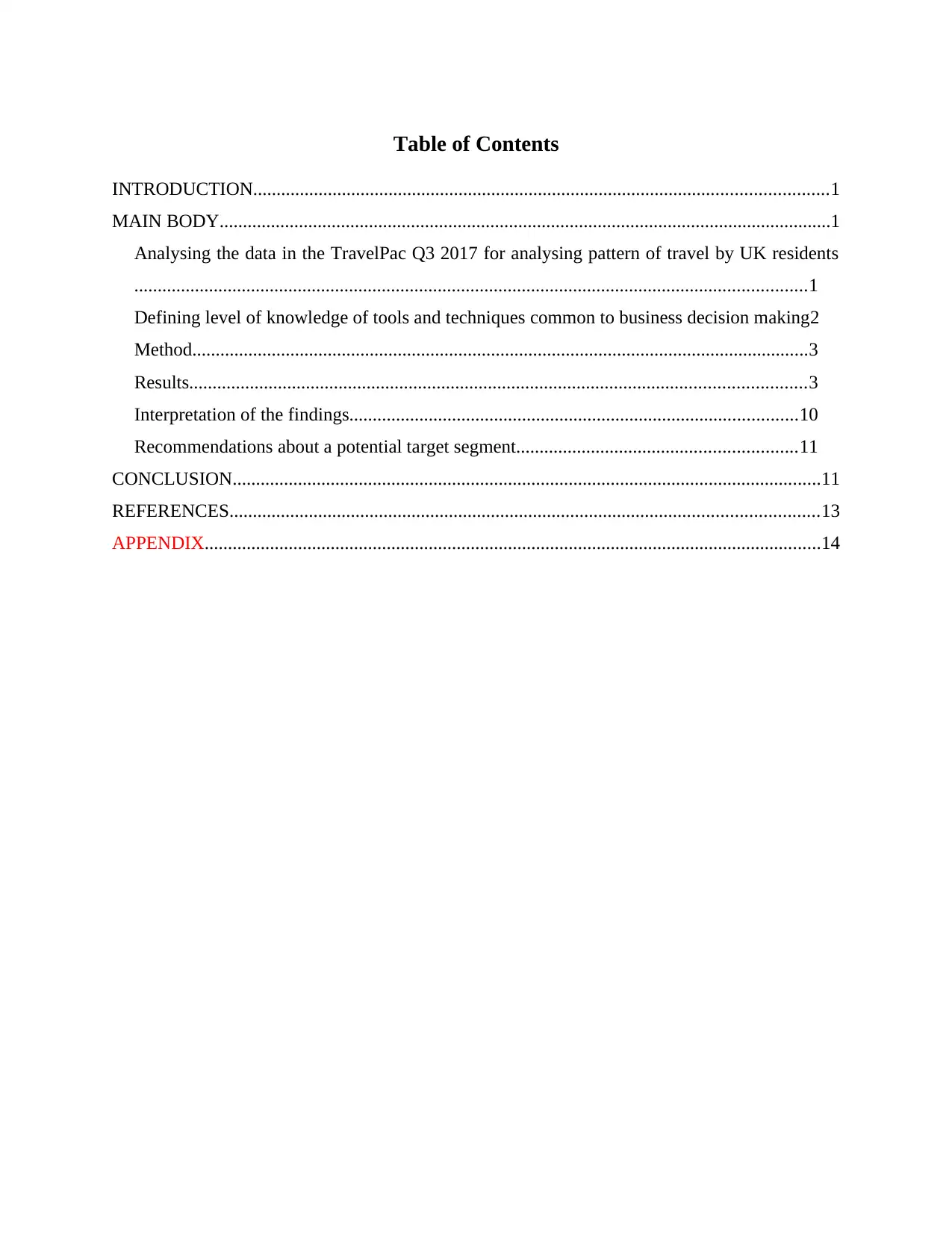
Table of Contents
INTRODUCTION...........................................................................................................................1
MAIN BODY...................................................................................................................................1
Analysing the data in the TravelPac Q3 2017 for analysing pattern of travel by UK residents
................................................................................................................................................1
Defining level of knowledge of tools and techniques common to business decision making2
Method....................................................................................................................................3
Results....................................................................................................................................3
Interpretation of the findings................................................................................................10
Recommendations about a potential target segment............................................................11
CONCLUSION..............................................................................................................................11
REFERENCES..............................................................................................................................13
APPENDIX....................................................................................................................................14
INTRODUCTION...........................................................................................................................1
MAIN BODY...................................................................................................................................1
Analysing the data in the TravelPac Q3 2017 for analysing pattern of travel by UK residents
................................................................................................................................................1
Defining level of knowledge of tools and techniques common to business decision making2
Method....................................................................................................................................3
Results....................................................................................................................................3
Interpretation of the findings................................................................................................10
Recommendations about a potential target segment............................................................11
CONCLUSION..............................................................................................................................11
REFERENCES..............................................................................................................................13
APPENDIX....................................................................................................................................14
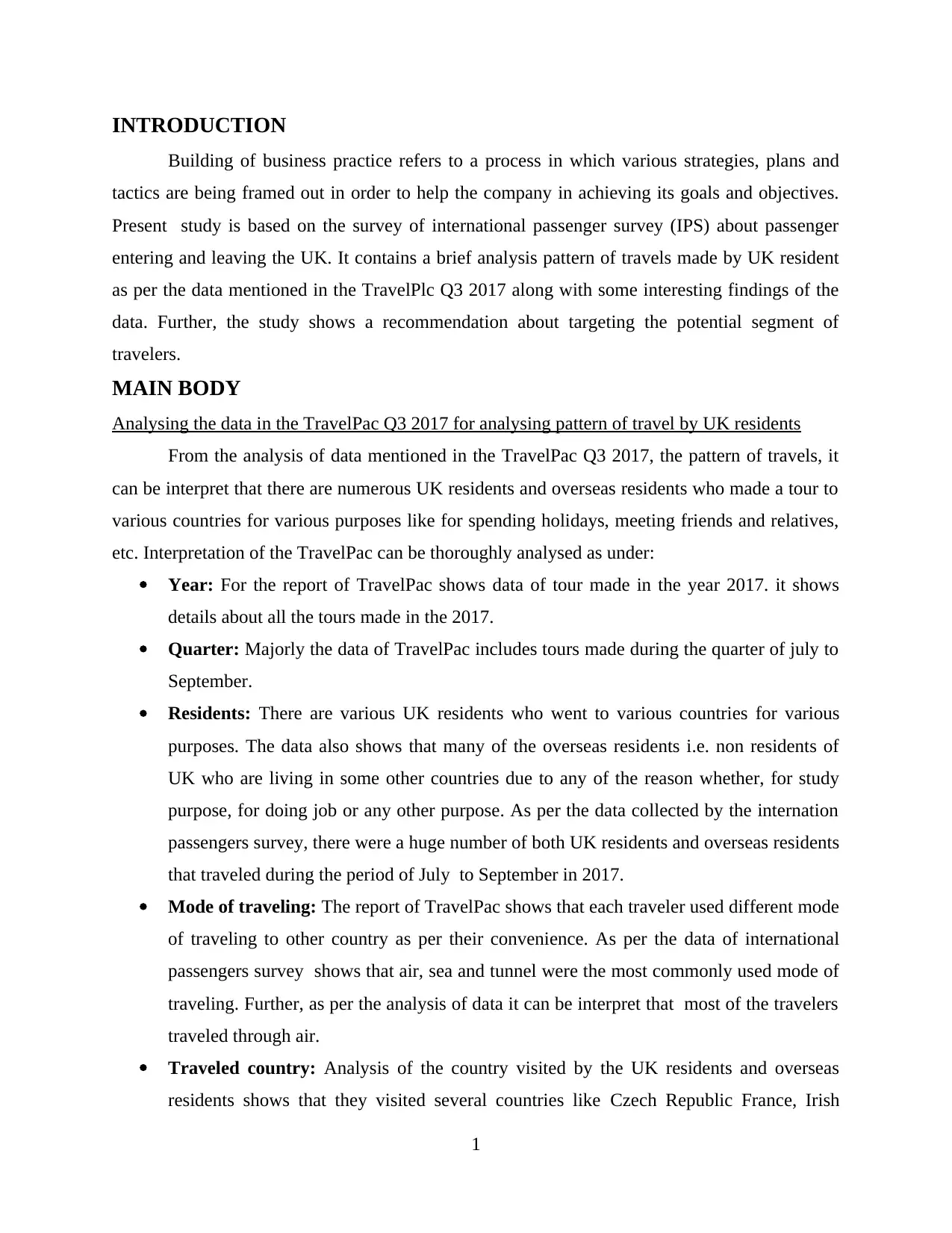
INTRODUCTION
Building of business practice refers to a process in which various strategies, plans and
tactics are being framed out in order to help the company in achieving its goals and objectives.
Present study is based on the survey of international passenger survey (IPS) about passenger
entering and leaving the UK. It contains a brief analysis pattern of travels made by UK resident
as per the data mentioned in the TravelPlc Q3 2017 along with some interesting findings of the
data. Further, the study shows a recommendation about targeting the potential segment of
travelers.
MAIN BODY
Analysing the data in the TravelPac Q3 2017 for analysing pattern of travel by UK residents
From the analysis of data mentioned in the TravelPac Q3 2017, the pattern of travels, it
can be interpret that there are numerous UK residents and overseas residents who made a tour to
various countries for various purposes like for spending holidays, meeting friends and relatives,
etc. Interpretation of the TravelPac can be thoroughly analysed as under:
Year: For the report of TravelPac shows data of tour made in the year 2017. it shows
details about all the tours made in the 2017.
Quarter: Majorly the data of TravelPac includes tours made during the quarter of july to
September.
Residents: There are various UK residents who went to various countries for various
purposes. The data also shows that many of the overseas residents i.e. non residents of
UK who are living in some other countries due to any of the reason whether, for study
purpose, for doing job or any other purpose. As per the data collected by the internation
passengers survey, there were a huge number of both UK residents and overseas residents
that traveled during the period of July to September in 2017.
Mode of traveling: The report of TravelPac shows that each traveler used different mode
of traveling to other country as per their convenience. As per the data of international
passengers survey shows that air, sea and tunnel were the most commonly used mode of
traveling. Further, as per the analysis of data it can be interpret that most of the travelers
traveled through air.
Traveled country: Analysis of the country visited by the UK residents and overseas
residents shows that they visited several countries like Czech Republic France, Irish
1
Building of business practice refers to a process in which various strategies, plans and
tactics are being framed out in order to help the company in achieving its goals and objectives.
Present study is based on the survey of international passenger survey (IPS) about passenger
entering and leaving the UK. It contains a brief analysis pattern of travels made by UK resident
as per the data mentioned in the TravelPlc Q3 2017 along with some interesting findings of the
data. Further, the study shows a recommendation about targeting the potential segment of
travelers.
MAIN BODY
Analysing the data in the TravelPac Q3 2017 for analysing pattern of travel by UK residents
From the analysis of data mentioned in the TravelPac Q3 2017, the pattern of travels, it
can be interpret that there are numerous UK residents and overseas residents who made a tour to
various countries for various purposes like for spending holidays, meeting friends and relatives,
etc. Interpretation of the TravelPac can be thoroughly analysed as under:
Year: For the report of TravelPac shows data of tour made in the year 2017. it shows
details about all the tours made in the 2017.
Quarter: Majorly the data of TravelPac includes tours made during the quarter of july to
September.
Residents: There are various UK residents who went to various countries for various
purposes. The data also shows that many of the overseas residents i.e. non residents of
UK who are living in some other countries due to any of the reason whether, for study
purpose, for doing job or any other purpose. As per the data collected by the internation
passengers survey, there were a huge number of both UK residents and overseas residents
that traveled during the period of July to September in 2017.
Mode of traveling: The report of TravelPac shows that each traveler used different mode
of traveling to other country as per their convenience. As per the data of international
passengers survey shows that air, sea and tunnel were the most commonly used mode of
traveling. Further, as per the analysis of data it can be interpret that most of the travelers
traveled through air.
Traveled country: Analysis of the country visited by the UK residents and overseas
residents shows that they visited several countries like Czech Republic France, Irish
1
⊘ This is a preview!⊘
Do you want full access?
Subscribe today to unlock all pages.

Trusted by 1+ million students worldwide
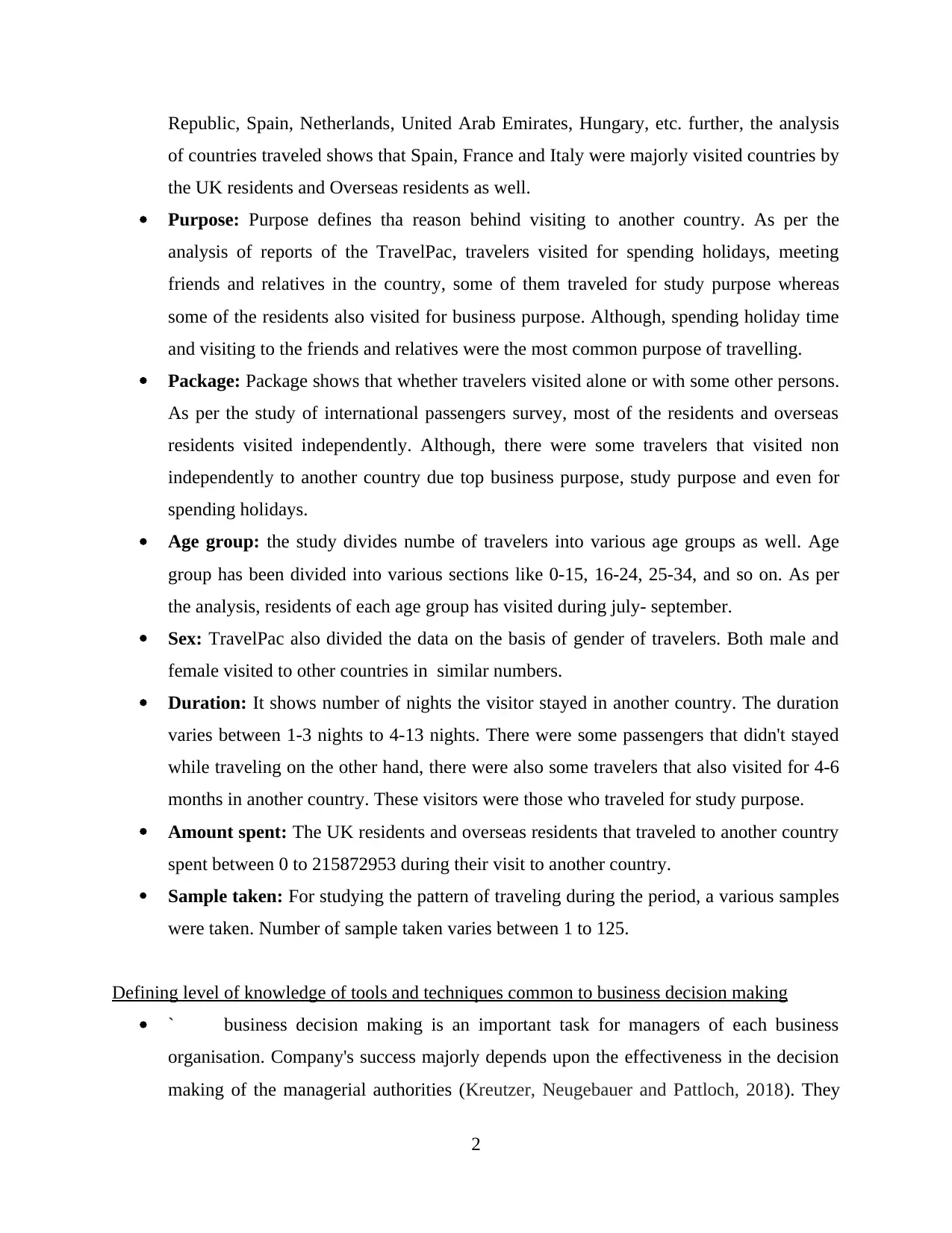
Republic, Spain, Netherlands, United Arab Emirates, Hungary, etc. further, the analysis
of countries traveled shows that Spain, France and Italy were majorly visited countries by
the UK residents and Overseas residents as well.
Purpose: Purpose defines tha reason behind visiting to another country. As per the
analysis of reports of the TravelPac, travelers visited for spending holidays, meeting
friends and relatives in the country, some of them traveled for study purpose whereas
some of the residents also visited for business purpose. Although, spending holiday time
and visiting to the friends and relatives were the most common purpose of travelling.
Package: Package shows that whether travelers visited alone or with some other persons.
As per the study of international passengers survey, most of the residents and overseas
residents visited independently. Although, there were some travelers that visited non
independently to another country due top business purpose, study purpose and even for
spending holidays.
Age group: the study divides numbe of travelers into various age groups as well. Age
group has been divided into various sections like 0-15, 16-24, 25-34, and so on. As per
the analysis, residents of each age group has visited during july- september.
Sex: TravelPac also divided the data on the basis of gender of travelers. Both male and
female visited to other countries in similar numbers.
Duration: It shows number of nights the visitor stayed in another country. The duration
varies between 1-3 nights to 4-13 nights. There were some passengers that didn't stayed
while traveling on the other hand, there were also some travelers that also visited for 4-6
months in another country. These visitors were those who traveled for study purpose.
Amount spent: The UK residents and overseas residents that traveled to another country
spent between 0 to 215872953 during their visit to another country.
Sample taken: For studying the pattern of traveling during the period, a various samples
were taken. Number of sample taken varies between 1 to 125.
Defining level of knowledge of tools and techniques common to business decision making
` business decision making is an important task for managers of each business
organisation. Company's success majorly depends upon the effectiveness in the decision
making of the managerial authorities (Kreutzer, Neugebauer and Pattloch, 2018). They
2
of countries traveled shows that Spain, France and Italy were majorly visited countries by
the UK residents and Overseas residents as well.
Purpose: Purpose defines tha reason behind visiting to another country. As per the
analysis of reports of the TravelPac, travelers visited for spending holidays, meeting
friends and relatives in the country, some of them traveled for study purpose whereas
some of the residents also visited for business purpose. Although, spending holiday time
and visiting to the friends and relatives were the most common purpose of travelling.
Package: Package shows that whether travelers visited alone or with some other persons.
As per the study of international passengers survey, most of the residents and overseas
residents visited independently. Although, there were some travelers that visited non
independently to another country due top business purpose, study purpose and even for
spending holidays.
Age group: the study divides numbe of travelers into various age groups as well. Age
group has been divided into various sections like 0-15, 16-24, 25-34, and so on. As per
the analysis, residents of each age group has visited during july- september.
Sex: TravelPac also divided the data on the basis of gender of travelers. Both male and
female visited to other countries in similar numbers.
Duration: It shows number of nights the visitor stayed in another country. The duration
varies between 1-3 nights to 4-13 nights. There were some passengers that didn't stayed
while traveling on the other hand, there were also some travelers that also visited for 4-6
months in another country. These visitors were those who traveled for study purpose.
Amount spent: The UK residents and overseas residents that traveled to another country
spent between 0 to 215872953 during their visit to another country.
Sample taken: For studying the pattern of traveling during the period, a various samples
were taken. Number of sample taken varies between 1 to 125.
Defining level of knowledge of tools and techniques common to business decision making
` business decision making is an important task for managers of each business
organisation. Company's success majorly depends upon the effectiveness in the decision
making of the managerial authorities (Kreutzer, Neugebauer and Pattloch, 2018). They
2
Paraphrase This Document
Need a fresh take? Get an instant paraphrase of this document with our AI Paraphraser
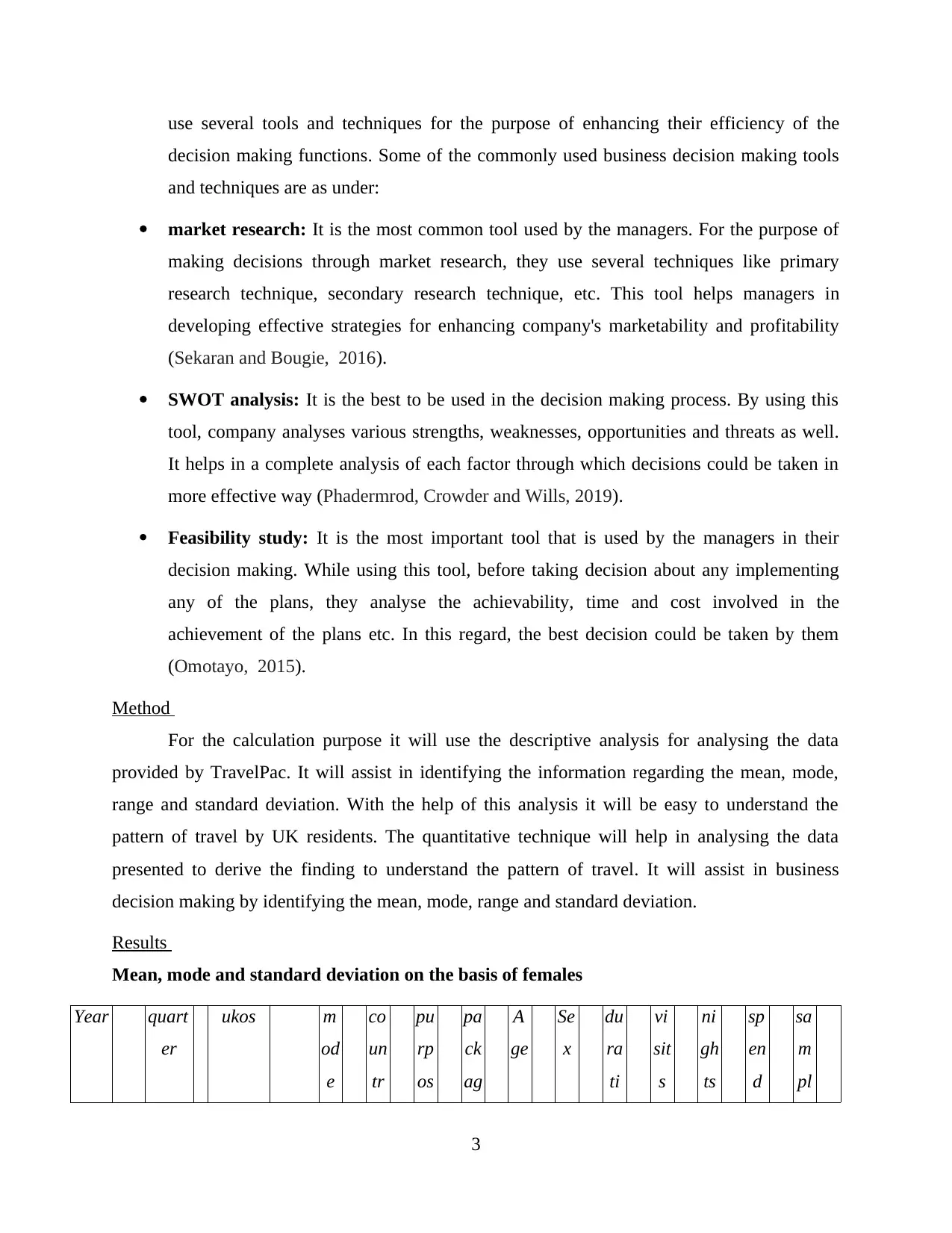
use several tools and techniques for the purpose of enhancing their efficiency of the
decision making functions. Some of the commonly used business decision making tools
and techniques are as under:
market research: It is the most common tool used by the managers. For the purpose of
making decisions through market research, they use several techniques like primary
research technique, secondary research technique, etc. This tool helps managers in
developing effective strategies for enhancing company's marketability and profitability
(Sekaran and Bougie, 2016).
SWOT analysis: It is the best to be used in the decision making process. By using this
tool, company analyses various strengths, weaknesses, opportunities and threats as well.
It helps in a complete analysis of each factor through which decisions could be taken in
more effective way (Phadermrod, Crowder and Wills, 2019).
Feasibility study: It is the most important tool that is used by the managers in their
decision making. While using this tool, before taking decision about any implementing
any of the plans, they analyse the achievability, time and cost involved in the
achievement of the plans etc. In this regard, the best decision could be taken by them
(Omotayo, 2015).
Method
For the calculation purpose it will use the descriptive analysis for analysing the data
provided by TravelPac. It will assist in identifying the information regarding the mean, mode,
range and standard deviation. With the help of this analysis it will be easy to understand the
pattern of travel by UK residents. The quantitative technique will help in analysing the data
presented to derive the finding to understand the pattern of travel. It will assist in business
decision making by identifying the mean, mode, range and standard deviation.
Results
Mean, mode and standard deviation on the basis of females
Year quart
er
ukos m
od
e
co
un
tr
pu
rp
os
pa
ck
ag
A
ge
Se
x
du
ra
ti
vi
sit
s
ni
gh
ts
sp
en
d
sa
m
pl
3
decision making functions. Some of the commonly used business decision making tools
and techniques are as under:
market research: It is the most common tool used by the managers. For the purpose of
making decisions through market research, they use several techniques like primary
research technique, secondary research technique, etc. This tool helps managers in
developing effective strategies for enhancing company's marketability and profitability
(Sekaran and Bougie, 2016).
SWOT analysis: It is the best to be used in the decision making process. By using this
tool, company analyses various strengths, weaknesses, opportunities and threats as well.
It helps in a complete analysis of each factor through which decisions could be taken in
more effective way (Phadermrod, Crowder and Wills, 2019).
Feasibility study: It is the most important tool that is used by the managers in their
decision making. While using this tool, before taking decision about any implementing
any of the plans, they analyse the achievability, time and cost involved in the
achievement of the plans etc. In this regard, the best decision could be taken by them
(Omotayo, 2015).
Method
For the calculation purpose it will use the descriptive analysis for analysing the data
provided by TravelPac. It will assist in identifying the information regarding the mean, mode,
range and standard deviation. With the help of this analysis it will be easy to understand the
pattern of travel by UK residents. The quantitative technique will help in analysing the data
presented to derive the finding to understand the pattern of travel. It will assist in business
decision making by identifying the mean, mode, range and standard deviation.
Results
Mean, mode and standard deviation on the basis of females
Year quart
er
ukos m
od
e
co
un
tr
pu
rp
os
pa
ck
ag
A
ge
Se
x
du
ra
ti
vi
sit
s
ni
gh
ts
sp
en
d
sa
m
pl
3
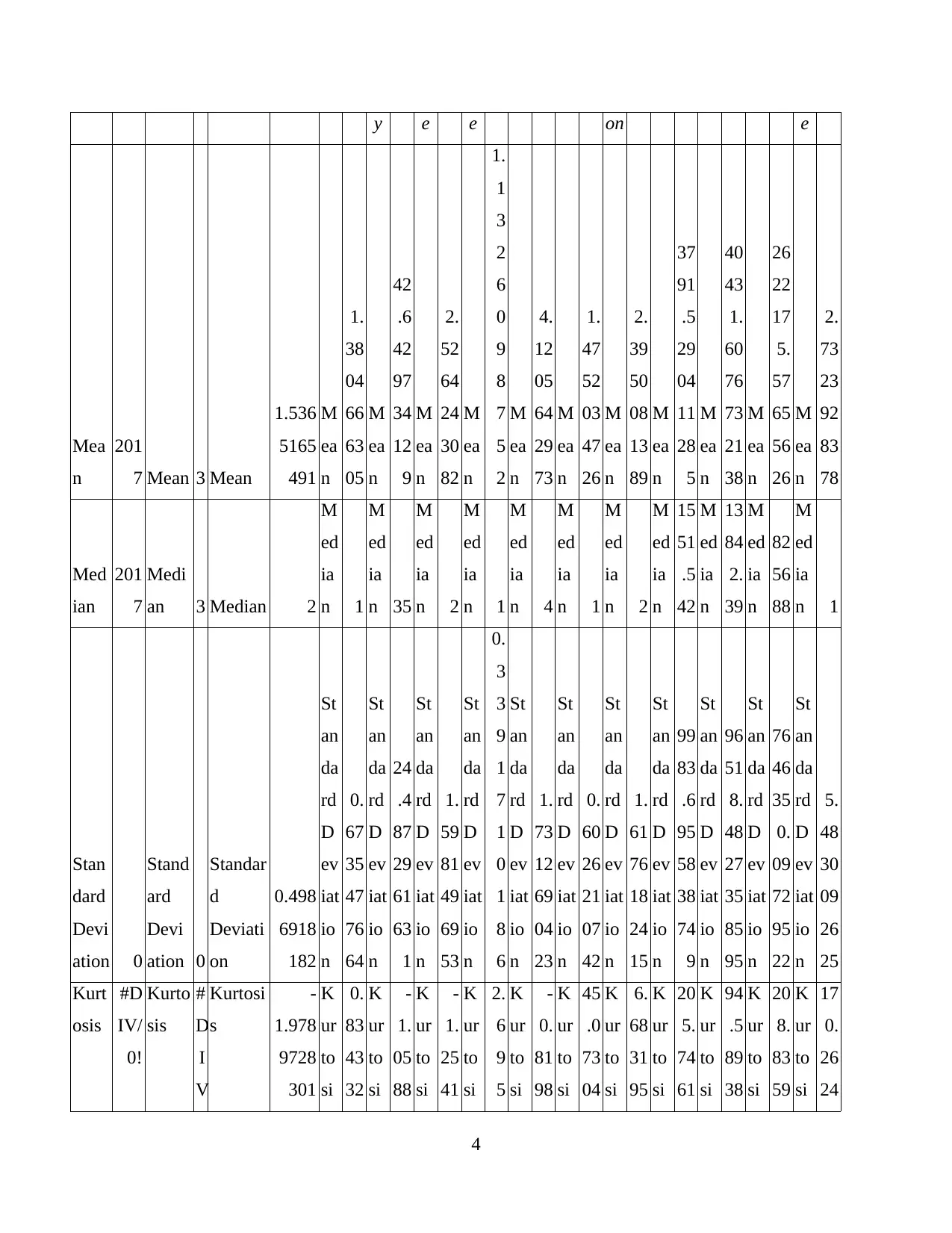
y e e on e
Mea
n
201
7 Mean 3 Mean
1.536
5165
491
M
ea
n
1.
38
04
66
63
05
M
ea
n
42
.6
42
97
34
12
9
M
ea
n
2.
52
64
24
30
82
M
ea
n
1.
1
3
2
6
0
9
8
7
5
2
M
ea
n
4.
12
05
64
29
73
M
ea
n
1.
47
52
03
47
26
M
ea
n
2.
39
50
08
13
89
M
ea
n
37
91
.5
29
04
11
28
5
M
ea
n
40
43
1.
60
76
73
21
38
M
ea
n
26
22
17
5.
57
65
56
26
M
ea
n
2.
73
23
92
83
78
Med
ian
201
7
Medi
an 3 Median 2
M
ed
ia
n 1
M
ed
ia
n 35
M
ed
ia
n 2
M
ed
ia
n 1
M
ed
ia
n 4
M
ed
ia
n 1
M
ed
ia
n 2
M
ed
ia
n
15
51
.5
42
M
ed
ia
n
13
84
2.
39
M
ed
ia
n
82
56
88
M
ed
ia
n 1
Stan
dard
Devi
ation 0
Stand
ard
Devi
ation 0
Standar
d
Deviati
on
0.498
6918
182
St
an
da
rd
D
ev
iat
io
n
0.
67
35
47
76
64
St
an
da
rd
D
ev
iat
io
n
24
.4
87
29
61
63
1
St
an
da
rd
D
ev
iat
io
n
1.
59
81
49
69
53
St
an
da
rd
D
ev
iat
io
n
0.
3
3
9
1
7
1
0
1
8
6
St
an
da
rd
D
ev
iat
io
n
1.
73
12
69
04
23
St
an
da
rd
D
ev
iat
io
n
0.
60
26
21
07
42
St
an
da
rd
D
ev
iat
io
n
1.
61
76
18
24
15
St
an
da
rd
D
ev
iat
io
n
99
83
.6
95
58
38
74
9
St
an
da
rd
D
ev
iat
io
n
96
51
8.
48
27
35
85
95
St
an
da
rd
D
ev
iat
io
n
76
46
35
0.
09
72
95
22
St
an
da
rd
D
ev
iat
io
n
5.
48
30
09
26
25
Kurt
osis
#D
IV/
0!
Kurto
sis
#
D
I
V
Kurtosi
s
-
1.978
9728
301
K
ur
to
si
0.
83
43
32
K
ur
to
si
-
1.
05
88
K
ur
to
si
-
1.
25
41
K
ur
to
si
2.
6
9
5
K
ur
to
si
-
0.
81
98
K
ur
to
si
45
.0
73
04
K
ur
to
si
6.
68
31
95
K
ur
to
si
20
5.
74
61
K
ur
to
si
94
.5
89
38
K
ur
to
si
20
8.
83
59
K
ur
to
si
17
0.
26
24
4
Mea
n
201
7 Mean 3 Mean
1.536
5165
491
M
ea
n
1.
38
04
66
63
05
M
ea
n
42
.6
42
97
34
12
9
M
ea
n
2.
52
64
24
30
82
M
ea
n
1.
1
3
2
6
0
9
8
7
5
2
M
ea
n
4.
12
05
64
29
73
M
ea
n
1.
47
52
03
47
26
M
ea
n
2.
39
50
08
13
89
M
ea
n
37
91
.5
29
04
11
28
5
M
ea
n
40
43
1.
60
76
73
21
38
M
ea
n
26
22
17
5.
57
65
56
26
M
ea
n
2.
73
23
92
83
78
Med
ian
201
7
Medi
an 3 Median 2
M
ed
ia
n 1
M
ed
ia
n 35
M
ed
ia
n 2
M
ed
ia
n 1
M
ed
ia
n 4
M
ed
ia
n 1
M
ed
ia
n 2
M
ed
ia
n
15
51
.5
42
M
ed
ia
n
13
84
2.
39
M
ed
ia
n
82
56
88
M
ed
ia
n 1
Stan
dard
Devi
ation 0
Stand
ard
Devi
ation 0
Standar
d
Deviati
on
0.498
6918
182
St
an
da
rd
D
ev
iat
io
n
0.
67
35
47
76
64
St
an
da
rd
D
ev
iat
io
n
24
.4
87
29
61
63
1
St
an
da
rd
D
ev
iat
io
n
1.
59
81
49
69
53
St
an
da
rd
D
ev
iat
io
n
0.
3
3
9
1
7
1
0
1
8
6
St
an
da
rd
D
ev
iat
io
n
1.
73
12
69
04
23
St
an
da
rd
D
ev
iat
io
n
0.
60
26
21
07
42
St
an
da
rd
D
ev
iat
io
n
1.
61
76
18
24
15
St
an
da
rd
D
ev
iat
io
n
99
83
.6
95
58
38
74
9
St
an
da
rd
D
ev
iat
io
n
96
51
8.
48
27
35
85
95
St
an
da
rd
D
ev
iat
io
n
76
46
35
0.
09
72
95
22
St
an
da
rd
D
ev
iat
io
n
5.
48
30
09
26
25
Kurt
osis
#D
IV/
0!
Kurto
sis
#
D
I
V
Kurtosi
s
-
1.978
9728
301
K
ur
to
si
0.
83
43
32
K
ur
to
si
-
1.
05
88
K
ur
to
si
-
1.
25
41
K
ur
to
si
2.
6
9
5
K
ur
to
si
-
0.
81
98
K
ur
to
si
45
.0
73
04
K
ur
to
si
6.
68
31
95
K
ur
to
si
20
5.
74
61
K
ur
to
si
94
.5
89
38
K
ur
to
si
20
8.
83
59
K
ur
to
si
17
0.
26
24
4
⊘ This is a preview!⊘
Do you want full access?
Subscribe today to unlock all pages.

Trusted by 1+ million students worldwide
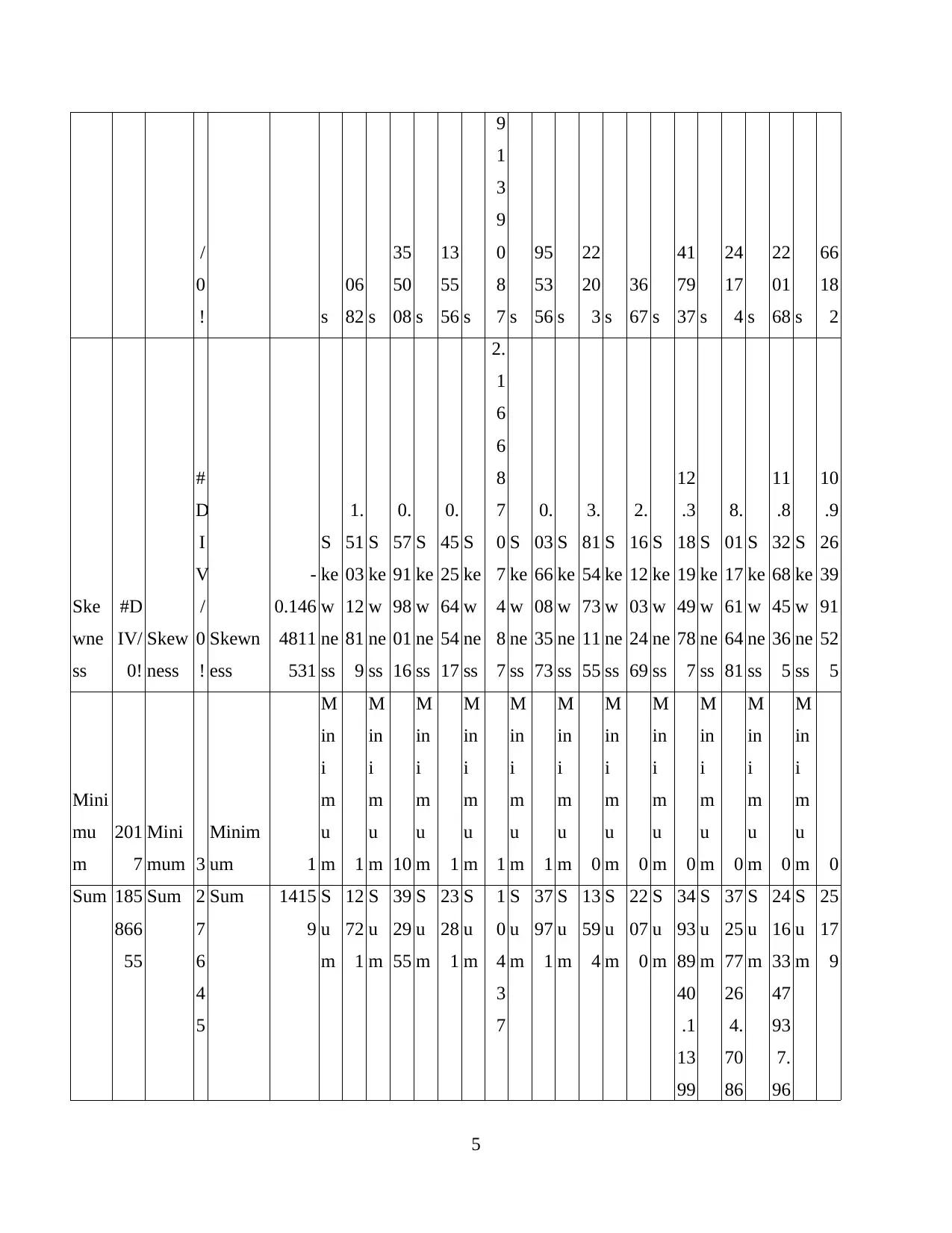
/
0
! s
06
82 s
35
50
08 s
13
55
56 s
9
1
3
9
0
8
7 s
95
53
56 s
22
20
3 s
36
67 s
41
79
37 s
24
17
4 s
22
01
68 s
66
18
2
Ske
wne
ss
#D
IV/
0!
Skew
ness
#
D
I
V
/
0
!
Skewn
ess
-
0.146
4811
531
S
ke
w
ne
ss
1.
51
03
12
81
9
S
ke
w
ne
ss
0.
57
91
98
01
16
S
ke
w
ne
ss
0.
45
25
64
54
17
S
ke
w
ne
ss
2.
1
6
6
8
7
0
7
4
8
7
S
ke
w
ne
ss
0.
03
66
08
35
73
S
ke
w
ne
ss
3.
81
54
73
11
55
S
ke
w
ne
ss
2.
16
12
03
24
69
S
ke
w
ne
ss
12
.3
18
19
49
78
7
S
ke
w
ne
ss
8.
01
17
61
64
81
S
ke
w
ne
ss
11
.8
32
68
45
36
5
S
ke
w
ne
ss
10
.9
26
39
91
52
5
Mini
mu
m
201
7
Mini
mum 3
Minim
um 1
M
in
i
m
u
m 1
M
in
i
m
u
m 10
M
in
i
m
u
m 1
M
in
i
m
u
m 1
M
in
i
m
u
m 1
M
in
i
m
u
m 0
M
in
i
m
u
m 0
M
in
i
m
u
m 0
M
in
i
m
u
m 0
M
in
i
m
u
m 0
M
in
i
m
u
m 0
Sum 185
866
55
Sum 2
7
6
4
5
Sum 1415
9
S
u
m
12
72
1
S
u
m
39
29
55
S
u
m
23
28
1
S
u
m
1
0
4
3
7
S
u
m
37
97
1
S
u
m
13
59
4
S
u
m
22
07
0
S
u
m
34
93
89
40
.1
13
99
S
u
m
37
25
77
26
4.
70
86
S
u
m
24
16
33
47
93
7.
96
S
u
m
25
17
9
5
0
! s
06
82 s
35
50
08 s
13
55
56 s
9
1
3
9
0
8
7 s
95
53
56 s
22
20
3 s
36
67 s
41
79
37 s
24
17
4 s
22
01
68 s
66
18
2
Ske
wne
ss
#D
IV/
0!
Skew
ness
#
D
I
V
/
0
!
Skewn
ess
-
0.146
4811
531
S
ke
w
ne
ss
1.
51
03
12
81
9
S
ke
w
ne
ss
0.
57
91
98
01
16
S
ke
w
ne
ss
0.
45
25
64
54
17
S
ke
w
ne
ss
2.
1
6
6
8
7
0
7
4
8
7
S
ke
w
ne
ss
0.
03
66
08
35
73
S
ke
w
ne
ss
3.
81
54
73
11
55
S
ke
w
ne
ss
2.
16
12
03
24
69
S
ke
w
ne
ss
12
.3
18
19
49
78
7
S
ke
w
ne
ss
8.
01
17
61
64
81
S
ke
w
ne
ss
11
.8
32
68
45
36
5
S
ke
w
ne
ss
10
.9
26
39
91
52
5
Mini
mu
m
201
7
Mini
mum 3
Minim
um 1
M
in
i
m
u
m 1
M
in
i
m
u
m 10
M
in
i
m
u
m 1
M
in
i
m
u
m 1
M
in
i
m
u
m 1
M
in
i
m
u
m 0
M
in
i
m
u
m 0
M
in
i
m
u
m 0
M
in
i
m
u
m 0
M
in
i
m
u
m 0
M
in
i
m
u
m 0
Sum 185
866
55
Sum 2
7
6
4
5
Sum 1415
9
S
u
m
12
72
1
S
u
m
39
29
55
S
u
m
23
28
1
S
u
m
1
0
4
3
7
S
u
m
37
97
1
S
u
m
13
59
4
S
u
m
22
07
0
S
u
m
34
93
89
40
.1
13
99
S
u
m
37
25
77
26
4.
70
86
S
u
m
24
16
33
47
93
7.
96
S
u
m
25
17
9
5
Paraphrase This Document
Need a fresh take? Get an instant paraphrase of this document with our AI Paraphraser
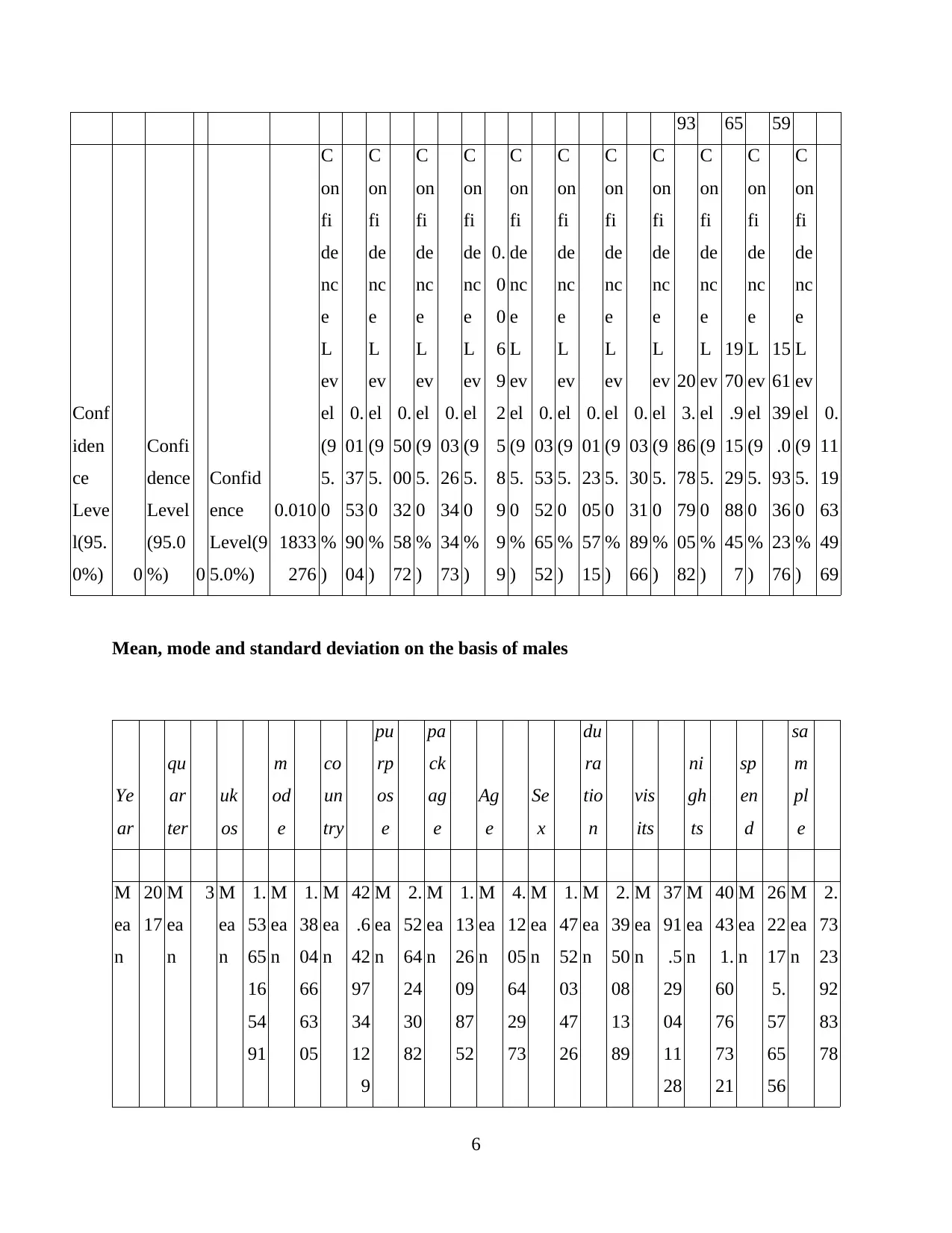
93 65 59
Conf
iden
ce
Leve
l(95.
0%) 0
Confi
dence
Level
(95.0
%) 0
Confid
ence
Level(9
5.0%)
0.010
1833
276
C
on
fi
de
nc
e
L
ev
el
(9
5.
0
%
)
0.
01
37
53
90
04
C
on
fi
de
nc
e
L
ev
el
(9
5.
0
%
)
0.
50
00
32
58
72
C
on
fi
de
nc
e
L
ev
el
(9
5.
0
%
)
0.
03
26
34
34
73
C
on
fi
de
nc
e
L
ev
el
(9
5.
0
%
)
0.
0
0
6
9
2
5
8
9
9
9
C
on
fi
de
nc
e
L
ev
el
(9
5.
0
%
)
0.
03
53
52
65
52
C
on
fi
de
nc
e
L
ev
el
(9
5.
0
%
)
0.
01
23
05
57
15
C
on
fi
de
nc
e
L
ev
el
(9
5.
0
%
)
0.
03
30
31
89
66
C
on
fi
de
nc
e
L
ev
el
(9
5.
0
%
)
20
3.
86
78
79
05
82
C
on
fi
de
nc
e
L
ev
el
(9
5.
0
%
)
19
70
.9
15
29
88
45
7
C
on
fi
de
nc
e
L
ev
el
(9
5.
0
%
)
15
61
39
.0
93
36
23
76
C
on
fi
de
nc
e
L
ev
el
(9
5.
0
%
)
0.
11
19
63
49
69
Mean, mode and standard deviation on the basis of males
Ye
ar
qu
ar
ter
uk
os
m
od
e
co
un
try
pu
rp
os
e
pa
ck
ag
e
Ag
e
Se
x
du
ra
tio
n
vis
its
ni
gh
ts
sp
en
d
sa
m
pl
e
M
ea
n
20
17
M
ea
n
3 M
ea
n
1.
53
65
16
54
91
M
ea
n
1.
38
04
66
63
05
M
ea
n
42
.6
42
97
34
12
9
M
ea
n
2.
52
64
24
30
82
M
ea
n
1.
13
26
09
87
52
M
ea
n
4.
12
05
64
29
73
M
ea
n
1.
47
52
03
47
26
M
ea
n
2.
39
50
08
13
89
M
ea
n
37
91
.5
29
04
11
28
M
ea
n
40
43
1.
60
76
73
21
M
ea
n
26
22
17
5.
57
65
56
M
ea
n
2.
73
23
92
83
78
6
Conf
iden
ce
Leve
l(95.
0%) 0
Confi
dence
Level
(95.0
%) 0
Confid
ence
Level(9
5.0%)
0.010
1833
276
C
on
fi
de
nc
e
L
ev
el
(9
5.
0
%
)
0.
01
37
53
90
04
C
on
fi
de
nc
e
L
ev
el
(9
5.
0
%
)
0.
50
00
32
58
72
C
on
fi
de
nc
e
L
ev
el
(9
5.
0
%
)
0.
03
26
34
34
73
C
on
fi
de
nc
e
L
ev
el
(9
5.
0
%
)
0.
0
0
6
9
2
5
8
9
9
9
C
on
fi
de
nc
e
L
ev
el
(9
5.
0
%
)
0.
03
53
52
65
52
C
on
fi
de
nc
e
L
ev
el
(9
5.
0
%
)
0.
01
23
05
57
15
C
on
fi
de
nc
e
L
ev
el
(9
5.
0
%
)
0.
03
30
31
89
66
C
on
fi
de
nc
e
L
ev
el
(9
5.
0
%
)
20
3.
86
78
79
05
82
C
on
fi
de
nc
e
L
ev
el
(9
5.
0
%
)
19
70
.9
15
29
88
45
7
C
on
fi
de
nc
e
L
ev
el
(9
5.
0
%
)
15
61
39
.0
93
36
23
76
C
on
fi
de
nc
e
L
ev
el
(9
5.
0
%
)
0.
11
19
63
49
69
Mean, mode and standard deviation on the basis of males
Ye
ar
qu
ar
ter
uk
os
m
od
e
co
un
try
pu
rp
os
e
pa
ck
ag
e
Ag
e
Se
x
du
ra
tio
n
vis
its
ni
gh
ts
sp
en
d
sa
m
pl
e
M
ea
n
20
17
M
ea
n
3 M
ea
n
1.
53
65
16
54
91
M
ea
n
1.
38
04
66
63
05
M
ea
n
42
.6
42
97
34
12
9
M
ea
n
2.
52
64
24
30
82
M
ea
n
1.
13
26
09
87
52
M
ea
n
4.
12
05
64
29
73
M
ea
n
1.
47
52
03
47
26
M
ea
n
2.
39
50
08
13
89
M
ea
n
37
91
.5
29
04
11
28
M
ea
n
40
43
1.
60
76
73
21
M
ea
n
26
22
17
5.
57
65
56
M
ea
n
2.
73
23
92
83
78
6
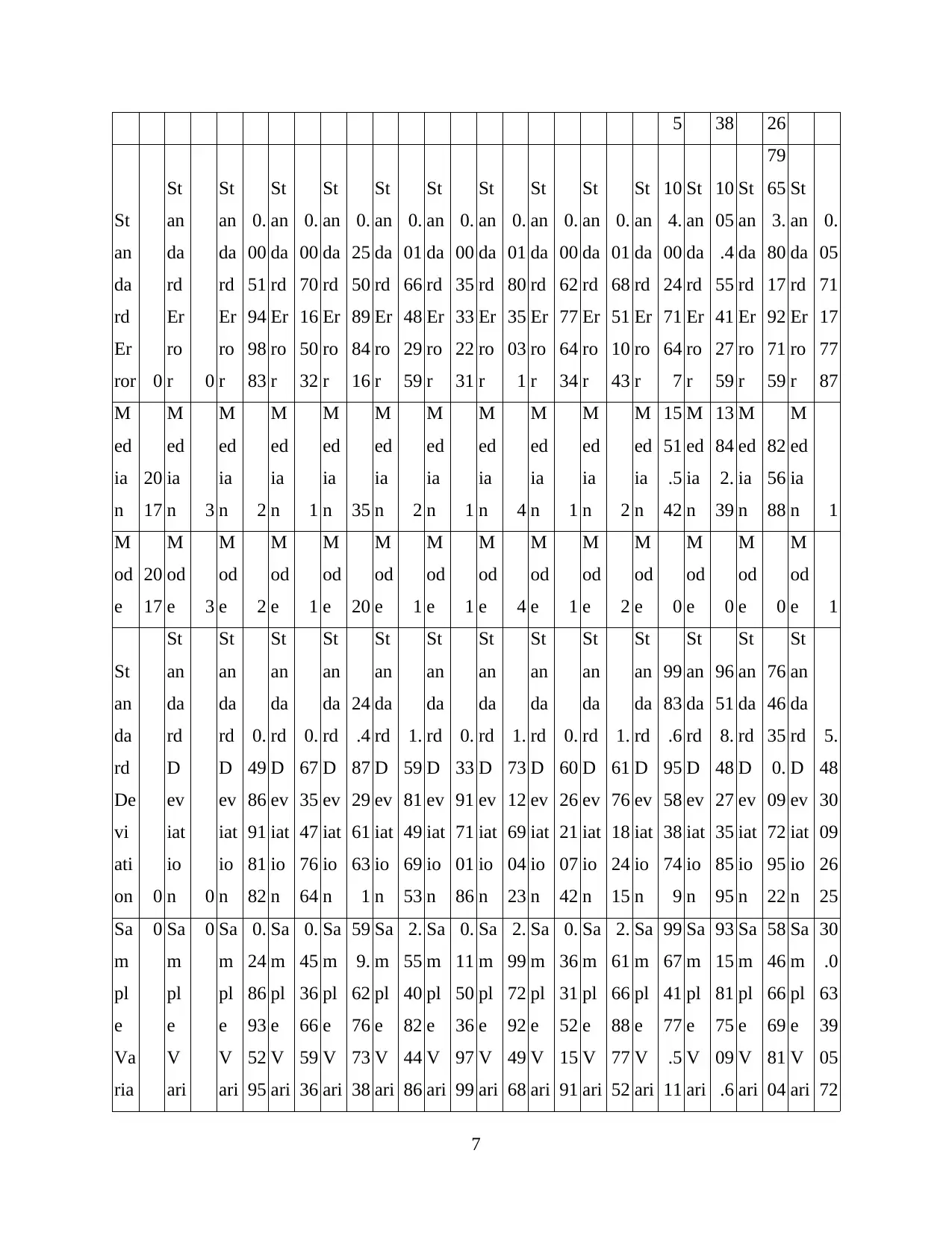
5 38 26
St
an
da
rd
Er
ror 0
St
an
da
rd
Er
ro
r 0
St
an
da
rd
Er
ro
r
0.
00
51
94
98
83
St
an
da
rd
Er
ro
r
0.
00
70
16
50
32
St
an
da
rd
Er
ro
r
0.
25
50
89
84
16
St
an
da
rd
Er
ro
r
0.
01
66
48
29
59
St
an
da
rd
Er
ro
r
0.
00
35
33
22
31
St
an
da
rd
Er
ro
r
0.
01
80
35
03
1
St
an
da
rd
Er
ro
r
0.
00
62
77
64
34
St
an
da
rd
Er
ro
r
0.
01
68
51
10
43
St
an
da
rd
Er
ro
r
10
4.
00
24
71
64
7
St
an
da
rd
Er
ro
r
10
05
.4
55
41
27
59
St
an
da
rd
Er
ro
r
79
65
3.
80
17
92
71
59
St
an
da
rd
Er
ro
r
0.
05
71
17
77
87
M
ed
ia
n
20
17
M
ed
ia
n 3
M
ed
ia
n 2
M
ed
ia
n 1
M
ed
ia
n 35
M
ed
ia
n 2
M
ed
ia
n 1
M
ed
ia
n 4
M
ed
ia
n 1
M
ed
ia
n 2
M
ed
ia
n
15
51
.5
42
M
ed
ia
n
13
84
2.
39
M
ed
ia
n
82
56
88
M
ed
ia
n 1
M
od
e
20
17
M
od
e 3
M
od
e 2
M
od
e 1
M
od
e 20
M
od
e 1
M
od
e 1
M
od
e 4
M
od
e 1
M
od
e 2
M
od
e 0
M
od
e 0
M
od
e 0
M
od
e 1
St
an
da
rd
De
vi
ati
on 0
St
an
da
rd
D
ev
iat
io
n 0
St
an
da
rd
D
ev
iat
io
n
0.
49
86
91
81
82
St
an
da
rd
D
ev
iat
io
n
0.
67
35
47
76
64
St
an
da
rd
D
ev
iat
io
n
24
.4
87
29
61
63
1
St
an
da
rd
D
ev
iat
io
n
1.
59
81
49
69
53
St
an
da
rd
D
ev
iat
io
n
0.
33
91
71
01
86
St
an
da
rd
D
ev
iat
io
n
1.
73
12
69
04
23
St
an
da
rd
D
ev
iat
io
n
0.
60
26
21
07
42
St
an
da
rd
D
ev
iat
io
n
1.
61
76
18
24
15
St
an
da
rd
D
ev
iat
io
n
99
83
.6
95
58
38
74
9
St
an
da
rd
D
ev
iat
io
n
96
51
8.
48
27
35
85
95
St
an
da
rd
D
ev
iat
io
n
76
46
35
0.
09
72
95
22
St
an
da
rd
D
ev
iat
io
n
5.
48
30
09
26
25
Sa
m
pl
e
Va
ria
0 Sa
m
pl
e
V
ari
0 Sa
m
pl
e
V
ari
0.
24
86
93
52
95
Sa
m
pl
e
V
ari
0.
45
36
66
59
36
Sa
m
pl
e
V
ari
59
9.
62
76
73
38
Sa
m
pl
e
V
ari
2.
55
40
82
44
86
Sa
m
pl
e
V
ari
0.
11
50
36
97
99
Sa
m
pl
e
V
ari
2.
99
72
92
49
68
Sa
m
pl
e
V
ari
0.
36
31
52
15
91
Sa
m
pl
e
V
ari
2.
61
66
88
77
52
Sa
m
pl
e
V
ari
99
67
41
77
.5
11
Sa
m
pl
e
V
ari
93
15
81
75
09
.6
Sa
m
pl
e
V
ari
58
46
66
69
81
04
Sa
m
pl
e
V
ari
30
.0
63
39
05
72
7
St
an
da
rd
Er
ror 0
St
an
da
rd
Er
ro
r 0
St
an
da
rd
Er
ro
r
0.
00
51
94
98
83
St
an
da
rd
Er
ro
r
0.
00
70
16
50
32
St
an
da
rd
Er
ro
r
0.
25
50
89
84
16
St
an
da
rd
Er
ro
r
0.
01
66
48
29
59
St
an
da
rd
Er
ro
r
0.
00
35
33
22
31
St
an
da
rd
Er
ro
r
0.
01
80
35
03
1
St
an
da
rd
Er
ro
r
0.
00
62
77
64
34
St
an
da
rd
Er
ro
r
0.
01
68
51
10
43
St
an
da
rd
Er
ro
r
10
4.
00
24
71
64
7
St
an
da
rd
Er
ro
r
10
05
.4
55
41
27
59
St
an
da
rd
Er
ro
r
79
65
3.
80
17
92
71
59
St
an
da
rd
Er
ro
r
0.
05
71
17
77
87
M
ed
ia
n
20
17
M
ed
ia
n 3
M
ed
ia
n 2
M
ed
ia
n 1
M
ed
ia
n 35
M
ed
ia
n 2
M
ed
ia
n 1
M
ed
ia
n 4
M
ed
ia
n 1
M
ed
ia
n 2
M
ed
ia
n
15
51
.5
42
M
ed
ia
n
13
84
2.
39
M
ed
ia
n
82
56
88
M
ed
ia
n 1
M
od
e
20
17
M
od
e 3
M
od
e 2
M
od
e 1
M
od
e 20
M
od
e 1
M
od
e 1
M
od
e 4
M
od
e 1
M
od
e 2
M
od
e 0
M
od
e 0
M
od
e 0
M
od
e 1
St
an
da
rd
De
vi
ati
on 0
St
an
da
rd
D
ev
iat
io
n 0
St
an
da
rd
D
ev
iat
io
n
0.
49
86
91
81
82
St
an
da
rd
D
ev
iat
io
n
0.
67
35
47
76
64
St
an
da
rd
D
ev
iat
io
n
24
.4
87
29
61
63
1
St
an
da
rd
D
ev
iat
io
n
1.
59
81
49
69
53
St
an
da
rd
D
ev
iat
io
n
0.
33
91
71
01
86
St
an
da
rd
D
ev
iat
io
n
1.
73
12
69
04
23
St
an
da
rd
D
ev
iat
io
n
0.
60
26
21
07
42
St
an
da
rd
D
ev
iat
io
n
1.
61
76
18
24
15
St
an
da
rd
D
ev
iat
io
n
99
83
.6
95
58
38
74
9
St
an
da
rd
D
ev
iat
io
n
96
51
8.
48
27
35
85
95
St
an
da
rd
D
ev
iat
io
n
76
46
35
0.
09
72
95
22
St
an
da
rd
D
ev
iat
io
n
5.
48
30
09
26
25
Sa
m
pl
e
Va
ria
0 Sa
m
pl
e
V
ari
0 Sa
m
pl
e
V
ari
0.
24
86
93
52
95
Sa
m
pl
e
V
ari
0.
45
36
66
59
36
Sa
m
pl
e
V
ari
59
9.
62
76
73
38
Sa
m
pl
e
V
ari
2.
55
40
82
44
86
Sa
m
pl
e
V
ari
0.
11
50
36
97
99
Sa
m
pl
e
V
ari
2.
99
72
92
49
68
Sa
m
pl
e
V
ari
0.
36
31
52
15
91
Sa
m
pl
e
V
ari
2.
61
66
88
77
52
Sa
m
pl
e
V
ari
99
67
41
77
.5
11
Sa
m
pl
e
V
ari
93
15
81
75
09
.6
Sa
m
pl
e
V
ari
58
46
66
69
81
04
Sa
m
pl
e
V
ari
30
.0
63
39
05
72
7
⊘ This is a preview!⊘
Do you want full access?
Subscribe today to unlock all pages.

Trusted by 1+ million students worldwide
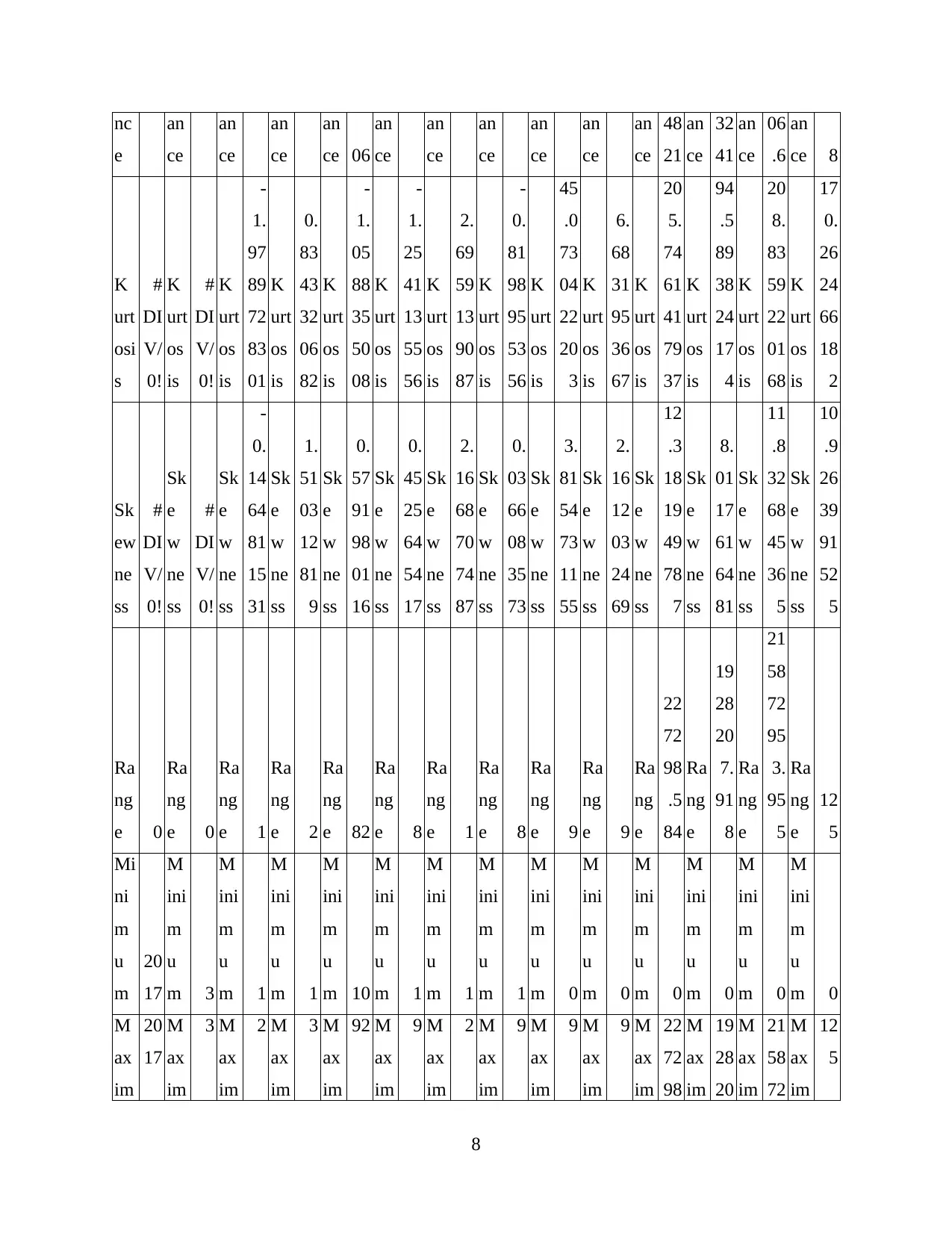
nc
e
an
ce
an
ce
an
ce
an
ce 06
an
ce
an
ce
an
ce
an
ce
an
ce
an
ce
48
21
an
ce
32
41
an
ce
06
.6
an
ce 8
K
urt
osi
s
#
DI
V/
0!
K
urt
os
is
#
DI
V/
0!
K
urt
os
is
-
1.
97
89
72
83
01
K
urt
os
is
0.
83
43
32
06
82
K
urt
os
is
-
1.
05
88
35
50
08
K
urt
os
is
-
1.
25
41
13
55
56
K
urt
os
is
2.
69
59
13
90
87
K
urt
os
is
-
0.
81
98
95
53
56
K
urt
os
is
45
.0
73
04
22
20
3
K
urt
os
is
6.
68
31
95
36
67
K
urt
os
is
20
5.
74
61
41
79
37
K
urt
os
is
94
.5
89
38
24
17
4
K
urt
os
is
20
8.
83
59
22
01
68
K
urt
os
is
17
0.
26
24
66
18
2
Sk
ew
ne
ss
#
DI
V/
0!
Sk
e
w
ne
ss
#
DI
V/
0!
Sk
e
w
ne
ss
-
0.
14
64
81
15
31
Sk
e
w
ne
ss
1.
51
03
12
81
9
Sk
e
w
ne
ss
0.
57
91
98
01
16
Sk
e
w
ne
ss
0.
45
25
64
54
17
Sk
e
w
ne
ss
2.
16
68
70
74
87
Sk
e
w
ne
ss
0.
03
66
08
35
73
Sk
e
w
ne
ss
3.
81
54
73
11
55
Sk
e
w
ne
ss
2.
16
12
03
24
69
Sk
e
w
ne
ss
12
.3
18
19
49
78
7
Sk
e
w
ne
ss
8.
01
17
61
64
81
Sk
e
w
ne
ss
11
.8
32
68
45
36
5
Sk
e
w
ne
ss
10
.9
26
39
91
52
5
Ra
ng
e 0
Ra
ng
e 0
Ra
ng
e 1
Ra
ng
e 2
Ra
ng
e 82
Ra
ng
e 8
Ra
ng
e 1
Ra
ng
e 8
Ra
ng
e 9
Ra
ng
e 9
Ra
ng
e
22
72
98
.5
84
Ra
ng
e
19
28
20
7.
91
8
Ra
ng
e
21
58
72
95
3.
95
5
Ra
ng
e
12
5
Mi
ni
m
u
m
20
17
M
ini
m
u
m 3
M
ini
m
u
m 1
M
ini
m
u
m 1
M
ini
m
u
m 10
M
ini
m
u
m 1
M
ini
m
u
m 1
M
ini
m
u
m 1
M
ini
m
u
m 0
M
ini
m
u
m 0
M
ini
m
u
m 0
M
ini
m
u
m 0
M
ini
m
u
m 0
M
ini
m
u
m 0
M
ax
im
20
17
M
ax
im
3 M
ax
im
2 M
ax
im
3 M
ax
im
92 M
ax
im
9 M
ax
im
2 M
ax
im
9 M
ax
im
9 M
ax
im
9 M
ax
im
22
72
98
M
ax
im
19
28
20
M
ax
im
21
58
72
M
ax
im
12
5
8
e
an
ce
an
ce
an
ce
an
ce 06
an
ce
an
ce
an
ce
an
ce
an
ce
an
ce
48
21
an
ce
32
41
an
ce
06
.6
an
ce 8
K
urt
osi
s
#
DI
V/
0!
K
urt
os
is
#
DI
V/
0!
K
urt
os
is
-
1.
97
89
72
83
01
K
urt
os
is
0.
83
43
32
06
82
K
urt
os
is
-
1.
05
88
35
50
08
K
urt
os
is
-
1.
25
41
13
55
56
K
urt
os
is
2.
69
59
13
90
87
K
urt
os
is
-
0.
81
98
95
53
56
K
urt
os
is
45
.0
73
04
22
20
3
K
urt
os
is
6.
68
31
95
36
67
K
urt
os
is
20
5.
74
61
41
79
37
K
urt
os
is
94
.5
89
38
24
17
4
K
urt
os
is
20
8.
83
59
22
01
68
K
urt
os
is
17
0.
26
24
66
18
2
Sk
ew
ne
ss
#
DI
V/
0!
Sk
e
w
ne
ss
#
DI
V/
0!
Sk
e
w
ne
ss
-
0.
14
64
81
15
31
Sk
e
w
ne
ss
1.
51
03
12
81
9
Sk
e
w
ne
ss
0.
57
91
98
01
16
Sk
e
w
ne
ss
0.
45
25
64
54
17
Sk
e
w
ne
ss
2.
16
68
70
74
87
Sk
e
w
ne
ss
0.
03
66
08
35
73
Sk
e
w
ne
ss
3.
81
54
73
11
55
Sk
e
w
ne
ss
2.
16
12
03
24
69
Sk
e
w
ne
ss
12
.3
18
19
49
78
7
Sk
e
w
ne
ss
8.
01
17
61
64
81
Sk
e
w
ne
ss
11
.8
32
68
45
36
5
Sk
e
w
ne
ss
10
.9
26
39
91
52
5
Ra
ng
e 0
Ra
ng
e 0
Ra
ng
e 1
Ra
ng
e 2
Ra
ng
e 82
Ra
ng
e 8
Ra
ng
e 1
Ra
ng
e 8
Ra
ng
e 9
Ra
ng
e 9
Ra
ng
e
22
72
98
.5
84
Ra
ng
e
19
28
20
7.
91
8
Ra
ng
e
21
58
72
95
3.
95
5
Ra
ng
e
12
5
Mi
ni
m
u
m
20
17
M
ini
m
u
m 3
M
ini
m
u
m 1
M
ini
m
u
m 1
M
ini
m
u
m 10
M
ini
m
u
m 1
M
ini
m
u
m 1
M
ini
m
u
m 1
M
ini
m
u
m 0
M
ini
m
u
m 0
M
ini
m
u
m 0
M
ini
m
u
m 0
M
ini
m
u
m 0
M
ini
m
u
m 0
M
ax
im
20
17
M
ax
im
3 M
ax
im
2 M
ax
im
3 M
ax
im
92 M
ax
im
9 M
ax
im
2 M
ax
im
9 M
ax
im
9 M
ax
im
9 M
ax
im
22
72
98
M
ax
im
19
28
20
M
ax
im
21
58
72
M
ax
im
12
5
8
Paraphrase This Document
Need a fresh take? Get an instant paraphrase of this document with our AI Paraphraser
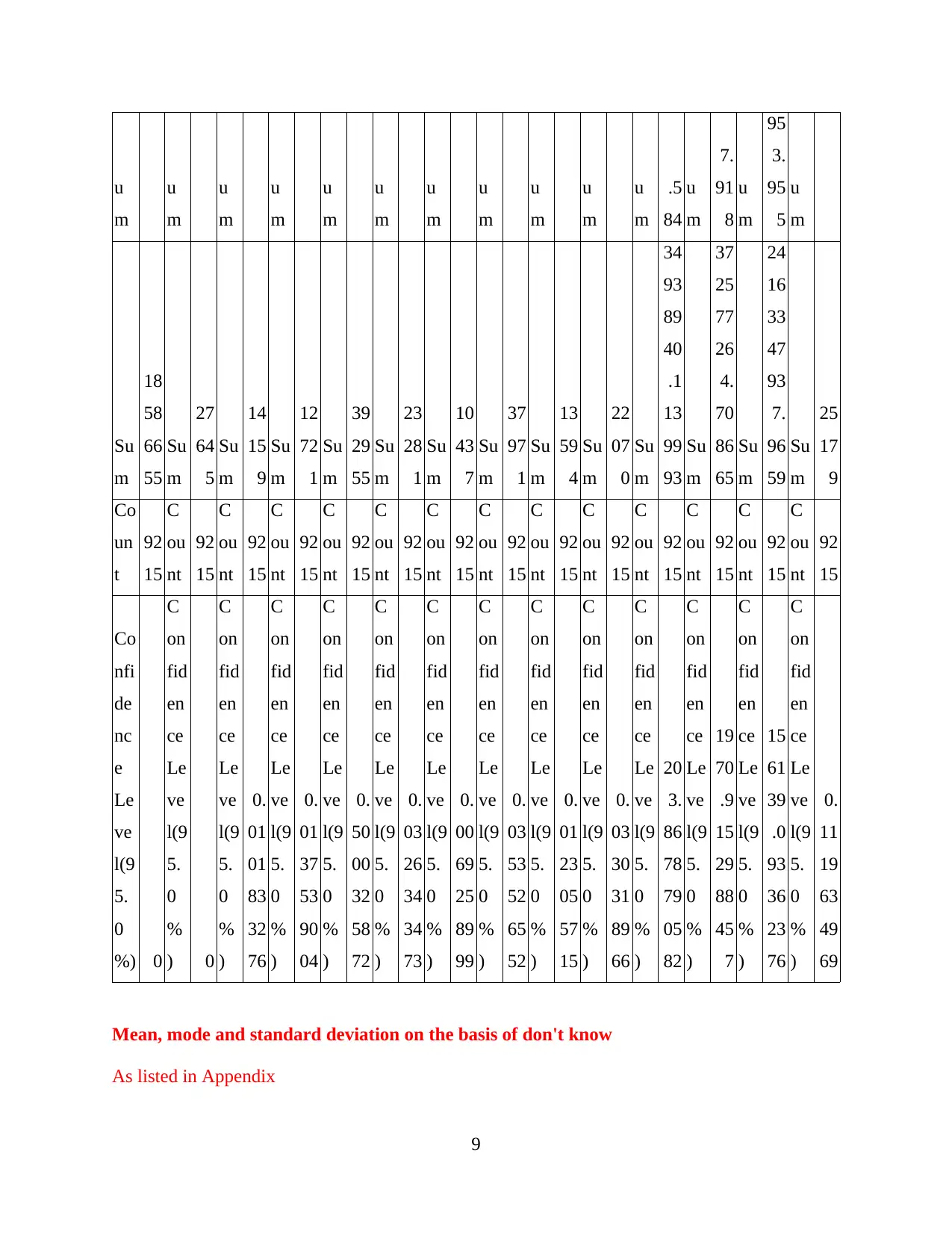
u
m
u
m
u
m
u
m
u
m
u
m
u
m
u
m
u
m
u
m
u
m
.5
84
u
m
7.
91
8
u
m
95
3.
95
5
u
m
Su
m
18
58
66
55
Su
m
27
64
5
Su
m
14
15
9
Su
m
12
72
1
Su
m
39
29
55
Su
m
23
28
1
Su
m
10
43
7
Su
m
37
97
1
Su
m
13
59
4
Su
m
22
07
0
Su
m
34
93
89
40
.1
13
99
93
Su
m
37
25
77
26
4.
70
86
65
Su
m
24
16
33
47
93
7.
96
59
Su
m
25
17
9
Co
un
t
92
15
C
ou
nt
92
15
C
ou
nt
92
15
C
ou
nt
92
15
C
ou
nt
92
15
C
ou
nt
92
15
C
ou
nt
92
15
C
ou
nt
92
15
C
ou
nt
92
15
C
ou
nt
92
15
C
ou
nt
92
15
C
ou
nt
92
15
C
ou
nt
92
15
C
ou
nt
92
15
Co
nfi
de
nc
e
Le
ve
l(9
5.
0
%) 0
C
on
fid
en
ce
Le
ve
l(9
5.
0
%
) 0
C
on
fid
en
ce
Le
ve
l(9
5.
0
%
)
0.
01
01
83
32
76
C
on
fid
en
ce
Le
ve
l(9
5.
0
%
)
0.
01
37
53
90
04
C
on
fid
en
ce
Le
ve
l(9
5.
0
%
)
0.
50
00
32
58
72
C
on
fid
en
ce
Le
ve
l(9
5.
0
%
)
0.
03
26
34
34
73
C
on
fid
en
ce
Le
ve
l(9
5.
0
%
)
0.
00
69
25
89
99
C
on
fid
en
ce
Le
ve
l(9
5.
0
%
)
0.
03
53
52
65
52
C
on
fid
en
ce
Le
ve
l(9
5.
0
%
)
0.
01
23
05
57
15
C
on
fid
en
ce
Le
ve
l(9
5.
0
%
)
0.
03
30
31
89
66
C
on
fid
en
ce
Le
ve
l(9
5.
0
%
)
20
3.
86
78
79
05
82
C
on
fid
en
ce
Le
ve
l(9
5.
0
%
)
19
70
.9
15
29
88
45
7
C
on
fid
en
ce
Le
ve
l(9
5.
0
%
)
15
61
39
.0
93
36
23
76
C
on
fid
en
ce
Le
ve
l(9
5.
0
%
)
0.
11
19
63
49
69
Mean, mode and standard deviation on the basis of don't know
As listed in Appendix
9
m
u
m
u
m
u
m
u
m
u
m
u
m
u
m
u
m
u
m
u
m
.5
84
u
m
7.
91
8
u
m
95
3.
95
5
u
m
Su
m
18
58
66
55
Su
m
27
64
5
Su
m
14
15
9
Su
m
12
72
1
Su
m
39
29
55
Su
m
23
28
1
Su
m
10
43
7
Su
m
37
97
1
Su
m
13
59
4
Su
m
22
07
0
Su
m
34
93
89
40
.1
13
99
93
Su
m
37
25
77
26
4.
70
86
65
Su
m
24
16
33
47
93
7.
96
59
Su
m
25
17
9
Co
un
t
92
15
C
ou
nt
92
15
C
ou
nt
92
15
C
ou
nt
92
15
C
ou
nt
92
15
C
ou
nt
92
15
C
ou
nt
92
15
C
ou
nt
92
15
C
ou
nt
92
15
C
ou
nt
92
15
C
ou
nt
92
15
C
ou
nt
92
15
C
ou
nt
92
15
C
ou
nt
92
15
Co
nfi
de
nc
e
Le
ve
l(9
5.
0
%) 0
C
on
fid
en
ce
Le
ve
l(9
5.
0
%
) 0
C
on
fid
en
ce
Le
ve
l(9
5.
0
%
)
0.
01
01
83
32
76
C
on
fid
en
ce
Le
ve
l(9
5.
0
%
)
0.
01
37
53
90
04
C
on
fid
en
ce
Le
ve
l(9
5.
0
%
)
0.
50
00
32
58
72
C
on
fid
en
ce
Le
ve
l(9
5.
0
%
)
0.
03
26
34
34
73
C
on
fid
en
ce
Le
ve
l(9
5.
0
%
)
0.
00
69
25
89
99
C
on
fid
en
ce
Le
ve
l(9
5.
0
%
)
0.
03
53
52
65
52
C
on
fid
en
ce
Le
ve
l(9
5.
0
%
)
0.
01
23
05
57
15
C
on
fid
en
ce
Le
ve
l(9
5.
0
%
)
0.
03
30
31
89
66
C
on
fid
en
ce
Le
ve
l(9
5.
0
%
)
20
3.
86
78
79
05
82
C
on
fid
en
ce
Le
ve
l(9
5.
0
%
)
19
70
.9
15
29
88
45
7
C
on
fid
en
ce
Le
ve
l(9
5.
0
%
)
15
61
39
.0
93
36
23
76
C
on
fid
en
ce
Le
ve
l(9
5.
0
%
)
0.
11
19
63
49
69
Mean, mode and standard deviation on the basis of don't know
As listed in Appendix
9
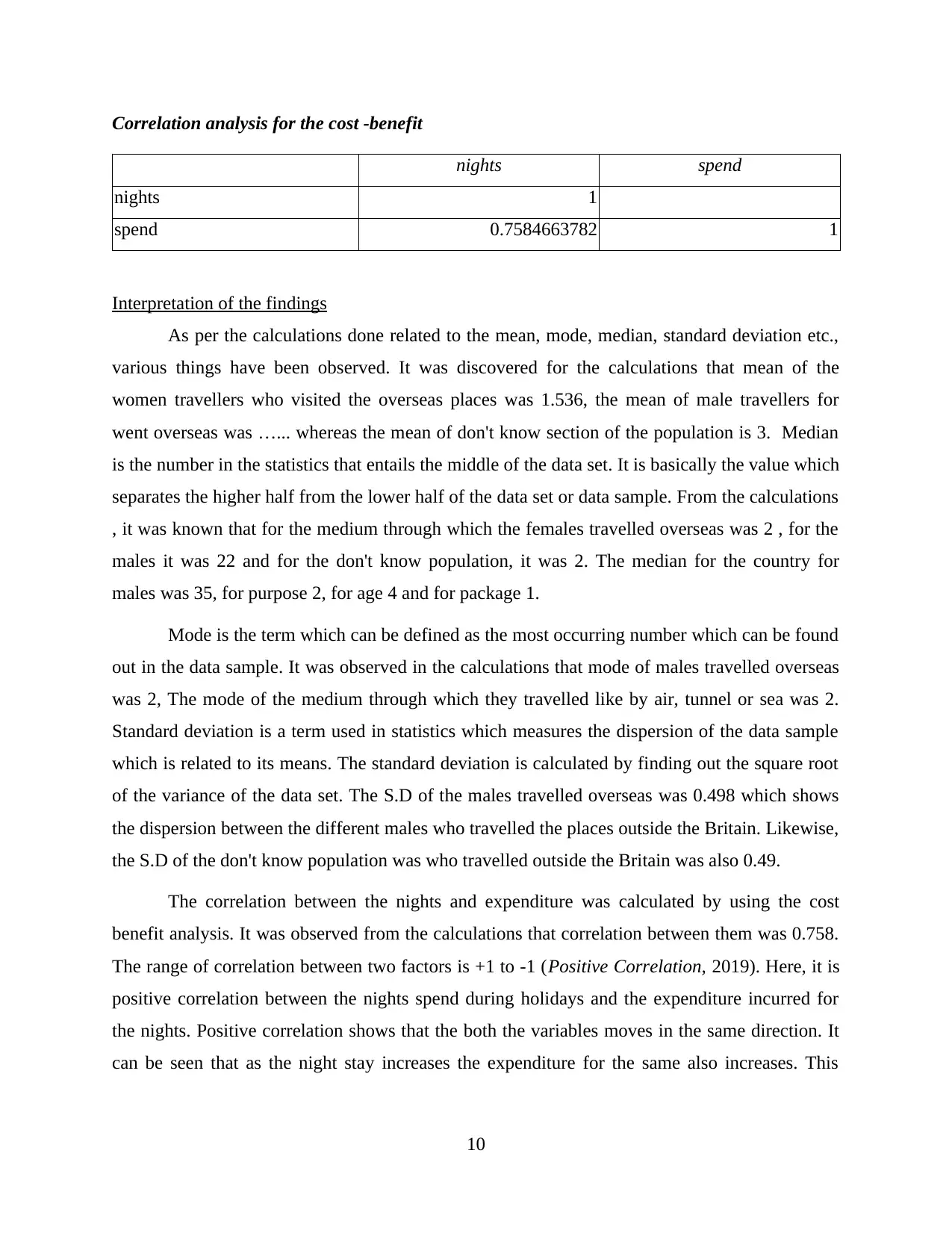
Correlation analysis for the cost -benefit
nights spend
nights 1
spend 0.7584663782 1
Interpretation of the findings
As per the calculations done related to the mean, mode, median, standard deviation etc.,
various things have been observed. It was discovered for the calculations that mean of the
women travellers who visited the overseas places was 1.536, the mean of male travellers for
went overseas was …... whereas the mean of don't know section of the population is 3. Median
is the number in the statistics that entails the middle of the data set. It is basically the value which
separates the higher half from the lower half of the data set or data sample. From the calculations
, it was known that for the medium through which the females travelled overseas was 2 , for the
males it was 22 and for the don't know population, it was 2. The median for the country for
males was 35, for purpose 2, for age 4 and for package 1.
Mode is the term which can be defined as the most occurring number which can be found
out in the data sample. It was observed in the calculations that mode of males travelled overseas
was 2, The mode of the medium through which they travelled like by air, tunnel or sea was 2.
Standard deviation is a term used in statistics which measures the dispersion of the data sample
which is related to its means. The standard deviation is calculated by finding out the square root
of the variance of the data set. The S.D of the males travelled overseas was 0.498 which shows
the dispersion between the different males who travelled the places outside the Britain. Likewise,
the S.D of the don't know population was who travelled outside the Britain was also 0.49.
The correlation between the nights and expenditure was calculated by using the cost
benefit analysis. It was observed from the calculations that correlation between them was 0.758.
The range of correlation between two factors is +1 to -1 (Positive Correlation, 2019). Here, it is
positive correlation between the nights spend during holidays and the expenditure incurred for
the nights. Positive correlation shows that the both the variables moves in the same direction. It
can be seen that as the night stay increases the expenditure for the same also increases. This
10
nights spend
nights 1
spend 0.7584663782 1
Interpretation of the findings
As per the calculations done related to the mean, mode, median, standard deviation etc.,
various things have been observed. It was discovered for the calculations that mean of the
women travellers who visited the overseas places was 1.536, the mean of male travellers for
went overseas was …... whereas the mean of don't know section of the population is 3. Median
is the number in the statistics that entails the middle of the data set. It is basically the value which
separates the higher half from the lower half of the data set or data sample. From the calculations
, it was known that for the medium through which the females travelled overseas was 2 , for the
males it was 22 and for the don't know population, it was 2. The median for the country for
males was 35, for purpose 2, for age 4 and for package 1.
Mode is the term which can be defined as the most occurring number which can be found
out in the data sample. It was observed in the calculations that mode of males travelled overseas
was 2, The mode of the medium through which they travelled like by air, tunnel or sea was 2.
Standard deviation is a term used in statistics which measures the dispersion of the data sample
which is related to its means. The standard deviation is calculated by finding out the square root
of the variance of the data set. The S.D of the males travelled overseas was 0.498 which shows
the dispersion between the different males who travelled the places outside the Britain. Likewise,
the S.D of the don't know population was who travelled outside the Britain was also 0.49.
The correlation between the nights and expenditure was calculated by using the cost
benefit analysis. It was observed from the calculations that correlation between them was 0.758.
The range of correlation between two factors is +1 to -1 (Positive Correlation, 2019). Here, it is
positive correlation between the nights spend during holidays and the expenditure incurred for
the nights. Positive correlation shows that the both the variables moves in the same direction. It
can be seen that as the night stay increases the expenditure for the same also increases. This
10
⊘ This is a preview!⊘
Do you want full access?
Subscribe today to unlock all pages.

Trusted by 1+ million students worldwide
1 out of 18
Related Documents
Your All-in-One AI-Powered Toolkit for Academic Success.
+13062052269
info@desklib.com
Available 24*7 on WhatsApp / Email
![[object Object]](/_next/static/media/star-bottom.7253800d.svg)
Unlock your academic potential
Copyright © 2020–2025 A2Z Services. All Rights Reserved. Developed and managed by ZUCOL.





